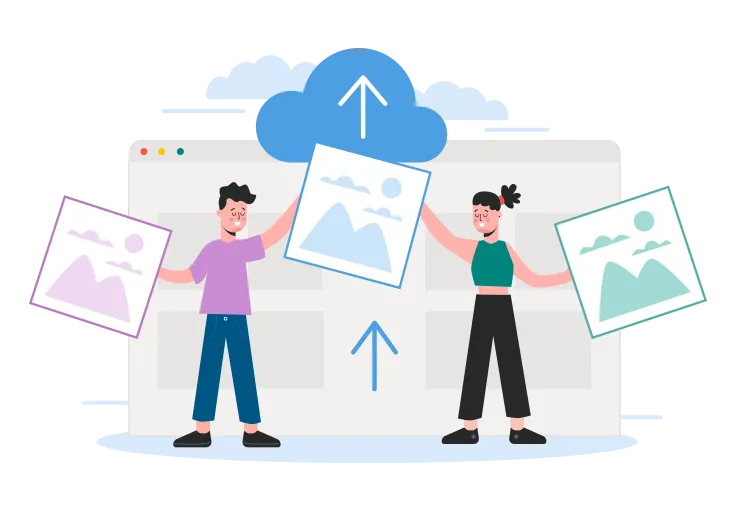
Our WebP to PNG Conversion Guide
Converting from WebP to PNG format is an excellent choice when you need lossless image quality and transparency support. While WebP offers excellent compression, PNG is widely compatible and provides superior quality for graphics, logos, and images with transparent elements. In this guide, we'll explore how to efficiently convert your WebP images to PNG format, the key differences between these formats, and when you should choose PNG over WebP for your specific needs.
What Do WebP and PNG Formats Mean?
WebP Format
WebP is a modern image format developed by Google that offers both lossy and lossless compression. It was designed specifically for web use, providing smaller file sizes compared to traditional formats while maintaining visual quality. WebP supports transparency and animation features, making it versatile for web applications. However, despite its advantages in compression efficiency, WebP isn't universally supported across all platforms and software, which can create compatibility challenges in certain environments.
PNG Format
PNG (Portable Network Graphics) is a widely supported lossless image format that excels at preserving image quality without any degradation. It offers full transparency support through an alpha channel, making it ideal for images with transparent backgrounds, logos, graphics with sharp edges, and text overlays. PNG files maintain perfect fidelity to the original image but typically result in larger file sizes compared to lossy formats. Their universal compatibility across virtually all platforms, browsers, and applications makes PNG a reliable choice for high-quality image preservation.
images.tr offers a powerful WebP to PNG converter that helps you maintain perfect image quality and transparency during the conversion process.

Free, Batch, and Fast WebP to PNG Conversion with images.tr
Converting from WebP to PNG requires a high-quality, reliable solution, especially when preserving transparency and image fidelity is critical. images.tr offers an exceptional service that allows you to convert your WebP images to PNG format with perfect quality preservation. Our powerful platform is completely free to use, with no hidden fees, watermarks, or limitations on the number of conversions.
Advantages of images.tr:
- 100% Free Service: All features are available at no cost, with absolutely no watermarks or premium tiers.
- Perfect Quality Preservation: Our conversion maintains every detail of your original WebP images in the PNG output.
- Transparency Support: All transparent elements in your WebP images are perfectly preserved in the PNG conversion.
- Batch Processing: Convert multiple WebP files to PNG simultaneously, saving significant time on large collections.
How to Convert WebP to PNG with images.tr?
- Upload your WebP files using our simple drag-and-drop interface or file selector.
- Select PNG as your target format from the available options.
- Start the conversion process with a single click on the "Convert" button.
- Download your newly converted PNG files individually or as a batch in a ZIP archive.
Batch Image Processing: Perfect for Designers and Developers
The batch processing capability of images.tr is particularly valuable for designers, developers, and content creators working with multiple images. Convert entire libraries of WebP images to PNG format in one simple operation, maintaining consistent quality across all files while saving hours of manual work.
Professional-Grade Conversion:
Our conversion algorithm ensures that your PNG files maintain the exact same visual quality as your original WebP images, making our service ideal for professional applications where image fidelity is critical. Whether you're creating assets for print, preparing images for software that doesn't support WebP, or archiving your visual content in a universally accessible format, our WebP to PNG converter delivers perfect results every time.

Everything is very easy with images.tr!
Converting from WebP to PNG is exceptionally straightforward with our user-friendly platform. No technical expertise or specialized software is required - our intuitive interface guides you through the process effortlessly. images.tr is designed to accommodate both casual users and professionals with its powerful yet simple conversion process.
Enjoy the best of both worlds by starting with WebP's efficient file sizes for web distribution, then converting to PNG when you need universal compatibility or perfect quality preservation. WebP to PNG conversion ensures your images will display correctly on all devices and platforms, with every detail and transparent element preserved exactly as intended. The process is quick and seamless, allowing you to focus on your creative work rather than technical conversion processes.
What Are the Differences Between WebP and PNG?
Understanding the key differences between WebP and PNG formats helps you make informed decisions about which format to use in different situations:
Advantages of WebP Format:
- Significantly smaller file sizes compared to PNG (often 25-35% smaller)
- Support for both lossy and lossless compression options
- Transparency support similar to PNG
- Animation capabilities (not available in PNG)
- Better for web optimization when file size is critical
Advantages of PNG Format:
- Perfect lossless quality with no compression artifacts
- Universal compatibility across all platforms and devices
- Excellent for graphics, logos, and text with sharp edges
- Superior alpha channel transparency handling
- Better support in image editing software and applications
- Ideal for images that require further editing


Why Should You Convert from WebP to PNG?
There are several compelling reasons to convert your WebP images to PNG format:
- Universal Compatibility: PNG is supported by virtually all devices, applications, browsers, and platforms, eliminating viewing problems.
- Perfect Quality Preservation: When quality is paramount, PNG's lossless compression ensures every detail is maintained.
- Superior Transparency: For images with transparency, PNG often provides better alpha channel handling, especially for complex transparent areas.
- Editing Workflow: Many image editing programs work better with PNG files, making them preferable if further editing is needed.
- Printing Applications: For images that may be printed, PNG provides better quality preservation than WebP.
- Archival Purposes: PNG is a better choice for long-term archiving due to its universal support and lossless nature.
- Legacy System Support: Older applications and systems may only recognize traditional formats like PNG.
Common Usage Areas of WebP and PNG
- WebP: Web optimization (especially Google-centric platforms), online stores requiring fast loading, progressive web applications, and situations where file size is the primary concern.
- PNG: Graphic design, logo creation, screenshots, digital illustrations, images with text, UI elements, images requiring transparency, and any situation where quality cannot be compromised.
Things to Consider When Converting from WebP to PNG
- File Size Increase: PNG files will typically be larger than their WebP counterparts, so ensure you have sufficient storage space for your converted files.
- Animation Loss: If your WebP images contain animation, converting to PNG will result in still images (typically the first frame). For animated content, consider GIF or video formats instead.
- Color Depth: PNG supports various color depths (8-bit, 24-bit, etc.). Our converter automatically selects the appropriate color depth based on your original image.


Optimizing PNG Images After Conversion
After converting your WebP files to PNG format, consider these optimization steps to get the most from your newly converted images:
- Use lossless PNG compression tools to reduce file size without affecting quality (images.tr automatically applies optimal compression).
- Resize your PNG images to the exact dimensions required for their intended use - avoid scaling them in HTML/CSS for best quality.
- Consider adding metadata like copyright information, descriptions, and keywords to your PNG files if they're going to be distributed.
- If file size is a concern, evaluate whether your specific use case truly requires PNG or if another format might be more appropriate.
- For web use, consider implementing responsive image techniques to serve different sizes based on the user's device.
Perfect Quality with WebP to PNG Conversion
Converting from WebP to PNG represents a strategic choice that prioritizes quality and compatibility over file size. While WebP offers excellent compression for web delivery, PNG provides unmatched quality preservation and universal support that ensures your images will display exactly as intended on any platform.
When PNG is the Right Choice:
- Graphic Design Work: For logos, illustrations, and other graphic elements where every pixel matters.
- Transparency Requirements: When your images have transparent elements that must render perfectly.
- Professional Publishing: For images that may be used in professional publications or printed materials.
- Software Development: When creating application assets that require perfect rendering across all platforms.
- Digital Asset Management: For archiving and organizing visual content in a universally accessible format.

Take Your Images to the Next Level with WebP to PNG
Converting your WebP images to PNG format with images.tr ensures perfect quality preservation while gaining universal compatibility. This conversion guarantees that your images will maintain every detail, sharp edge, and transparent element exactly as intended, regardless of where they're viewed or how they're used. The process is fast, free, and designed to deliver professional-grade results every time.
Whether you're a designer needing precise quality control, a developer requiring cross-platform compatibility, or a content creator wanting to ensure your visual assets display perfectly for every viewer, WebP to PNG conversion provides the ideal solution. With images.tr's powerful yet simple tools, you can convert your entire image collection with confidence, knowing that quality will never be compromised.
Frequently asked questions about WEBP
What is WEBP?
WEBP is a modern image format that offers high compression rates and quality images. It supports both lossy and lossless compression.
How can I compress WEBP files?
You can compress WEBP files using online tools or software; this preserves quality while reducing file size.
What are the advantages of WEBP?
WEBP provides smaller file sizes and faster loading times compared to JPG and PNG, making it ideal for websites.
Which formats can I convert WEBP files to?
You can convert WEBP files to JPG, PNG, AVIF, and HEIC formats. Each format offers different advantages for specific uses.
Does WEBP support transparency?
Yes, WEBP supports alpha channel transparency similar to PNG but with smaller file sizes.
What browsers support WEBP?
Most modern browsers including Chrome, Firefox, Edge, and Safari support WEBP. However, some older browsers may require alternative formats.
Does WEBP work on mobile devices?
Yes, most modern mobile devices and browsers support WEBP, but compatibility should be checked for older devices.
How is WEBP different from JPG?
WEBP offers better compression than JPG and supports transparency. It provides similar quality images at smaller file sizes.
Can I convert JPG to WEBP?
Yes, you can convert JPG to WEBP using various online tools or software. This often results in smaller file sizes.
What is the typical file size reduction with WEBP?
WEBP typically reduces file sizes by 25-35% compared to JPG, and significantly more compared to PNG files with transparency.
How does WEBP impact SEO and website performance?
WEBP images can improve page loading speed, which positively affects SEO rankings. Faster websites also provide better user experience.
How does WEBP compare to AVIF?
AVIF generally offers better compression than WEBP, but WEBP has wider browser support. AVIF is newer and still gaining adoption.
Can I resize WEBP images?
Yes, you can resize WEBP images just like any other image format using various online tools or image editing software.
Frequently asked questions about PNG
What is PNG compression?
PNG compression is a lossless process that reduces file size while preserving image quality. This provides faster loading times for websites.
Why are PNG files lossless?
The PNG format stores data without loss during compression. This makes it ideal for graphics and logos.
Which formats can I convert PNG files to?
You can convert PNG files to formats like JPG, WEBP, AVIF, and HEIC. Each format has its own unique advantages.
Why is resizing PNG files important?
Resizing improves web page loading speed and enhances user experience. It's also suitable for social media sharing.
What are the advantages of PNG?
PNG offers transparency support and high-quality lossless compression. This is a major advantage for graphic designers.
Is there quality loss when compressing PNG files?
No, PNG compression is lossless, so image quality is preserved.
What are the benefits of converting PNG files to JPG?
The JPG format offers smaller file sizes, providing faster loading for web use.
Why can PNG files be large?
PNG files can have larger file sizes for detailed images because they use lossless compression.
What does converting PNG to WEBP accomplish?
WEBP offers better compression and provides smaller file sizes with faster loading times.
What are the best compression settings for PNG files?
It's best to adjust the compression level according to the purpose of the image, considering settings that affect image quality.
How does PNG format contribute to SEO?
Optimized PNG files improve web page loading speed, which positively affects SEO.
How can I convert PNG to AVIF format?
You can use online converters or specialized software to convert your PNG file to AVIF format.
How is transparency achieved in PNG files?
PNG format provides transparency support through an alpha channel, allowing backgrounds to appear as desired.
Why is backing up PNG files important?
High-quality and lossless PNG files are important for preserving your projects, so regular backups should be made.
Published on .